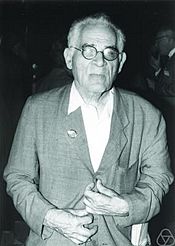Louis J. Mordell facts for kids
Quick facts for kids
Louis Mordell
|
|
|---|---|

Louis Mordell in Nice, 1970.
|
|
| Born |
Louis Joel Mordell
28 January 1888 |
| Died | 12 March 1972 (aged 84) |
| Nationality | British |
| Alma mater | St John's College, Cambridge |
| Known for | Mordell conjecture Chowla–Mordell theorem Erdős–Mordell inequality Mordell–Weil theorem Mordell curve |
| Spouse(s) | Mabel Elizabeth Cambridge |
| Children | Kathleen, Donald |
| Awards | Smith's Prize (1912) De Morgan Medal (1941) Senior Berwick Prize (1946) Sylvester Medal (1949) Fellow of the Royal Society |
| Scientific career | |
| Fields | Mathematics |
| Institutions | Birkbeck College UMIST Victoria University of Manchester University of Cambridge |
| Doctoral advisor | Henry Frederick Baker |
| Doctoral students | Ram Prakash Bambah J. W. S. Cassels |
Louis Joel Mordell (born January 28, 1888 – died March 12, 1972) was a very important mathematician. He was born in Philadelphia, United States. Later, he became a British citizen. He is famous for his groundbreaking work in number theory, which is a branch of mathematics that studies whole numbers and their properties.
Becoming a Mathematician
Louis Mordell went to the University of Cambridge in England. He started studying there in 1906. He was a student at St John's College, Cambridge. He did very well in his math exams, called the Cambridge Mathematical Tripos. In 1909, he graduated as the "third wrangler." This means he was the third best math student in his year.
His Amazing Discoveries
After finishing his studies, Mordell started his own research. He was very interested in special types of math problems called diophantine equations. These equations look for whole number solutions. One famous equation he studied was called the Mordell equation:
- y2 = x3 + k.
He started teaching at Birkbeck College in London in 1913. Even during World War I, he kept working on math. In 1917, he made a big discovery about something called Srinivasa Ramanujan's tau-function. This was a major step forward in a complex area of math called modular form theory.
In 1920, he moved to UMIST to teach. By 1922, he became a top professor at the University of Manchester. There, he explored another part of number theory called the geometry of numbers.
His most famous work, Mordell's theorem, came out around 1921-1922. He also came up with the idea for the Mordell conjecture. This was a very challenging math problem that was finally solved many years later. He was invited to speak at major math conferences around the world.
Louis Mordell became a British citizen in 1929. In Manchester, he helped build a strong math department. He invited many brilliant mathematicians to work there. Some of them had to leave their jobs in Europe because of difficult times. He helped mathematicians like Paul Erdős and Kurt Mahler.
In 1945, he went back to Cambridge University. He became a professor and the head of the math department. He officially retired in 1953. Even though he was a professor, he didn't have many formal students. He once joked that proving a very difficult math problem was probably worth a doctorate degree! His book, Diophantine Equations, shares his ideas from his lectures. People said he didn't like doing office work very much.
A Funny Story
When Louis Mordell was older, he visited the University of Calgary. He would often attend math seminars there. Sometimes, he would fall asleep during them!
One time, a number theorist named Richard K. Guy told a funny story. During a seminar, Mordell fell asleep. Someone in the audience asked, "Isn't that Stickelberger's theorem?" The speaker said no. A few minutes later, the person asked again, "I'm positive that's Stickelberger's theorem!" The speaker still said no.
When the lecture ended, the applause woke up Mordell. He looked up at the board and said, "There's old Stickelberger's result!" It seems he knew the math even while napping!
See also
- Mordell–Weil group

